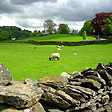ROMANS IN ST ALBANS
Verulamium Museum, Roman Theater and Park
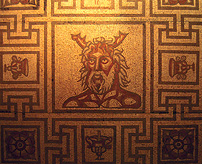 The
city of St Albans in Hertfordshire has an ancient history, once the
location of one of the largest Roman towns in Britannia, now mostly
buried under a large grassy park on the eastern outskirts of the current
city. The Verulamium Park on any average day is taken over my mothers
with baby strollers, joggers near the playground and miniature golf.
But on the third weekend of the every month Roman Legions invade once
again
to
occupy
their
abandoned
posts.
Not ghosts, but living history re-enactors, representing life in Roman
times.
The
city of St Albans in Hertfordshire has an ancient history, once the
location of one of the largest Roman towns in Britannia, now mostly
buried under a large grassy park on the eastern outskirts of the current
city. The Verulamium Park on any average day is taken over my mothers
with baby strollers, joggers near the playground and miniature golf.
But on the third weekend of the every month Roman Legions invade once
again
to
occupy
their
abandoned
posts.
Not ghosts, but living history re-enactors, representing life in Roman
times.
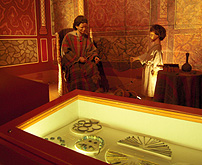 The
Romans invaded southern Britain in 43 AD establishing a number of outposts
and town. The third largest Roman Town was Verulamium protecting
a ford across the River Ver, 20 miles north of the main city of Londonium.
When the town was laid out ten years later around in 55 AD in the time
of Emperor Nero, the Romans left remaining an area of the marshes where
the local
Celtic tribe could practice their rituals of worship to the Catuvallaunian
Gods. The Briton Celtic Queen Boudicca (Boadicea) wasn't satisfied
with this minor nod of the invaders to local custom and in 60 AD led
a tribal
army against the Romans and burnt the first Verulamium to the ground.
The Romans ultimately defeated the Celts - at least for a time - and
after the death of the queen rebuilt the city grander than before.
The
Romans invaded southern Britain in 43 AD establishing a number of outposts
and town. The third largest Roman Town was Verulamium protecting
a ford across the River Ver, 20 miles north of the main city of Londonium.
When the town was laid out ten years later around in 55 AD in the time
of Emperor Nero, the Romans left remaining an area of the marshes where
the local
Celtic tribe could practice their rituals of worship to the Catuvallaunian
Gods. The Briton Celtic Queen Boudicca (Boadicea) wasn't satisfied
with this minor nod of the invaders to local custom and in 60 AD led
a tribal
army against the Romans and burnt the first Verulamium to the ground.
The Romans ultimately defeated the Celts - at least for a time - and
after the death of the queen rebuilt the city grander than before.
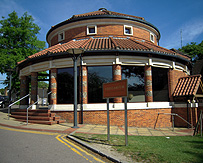 Much
of the Verulamium Roman city’s 300 acres is still buried,
once consisting of several very large municipal buildings - the massive
town hall called the "Basilica", which also served as religious
center and law court and the colonnaded "Forum" which was the
center of the city’s daily commerce. The visible remains of the
Roman city consist of a Roman Theater (not an amphitheater), the bathhouse
of a Roman villa, the “Hypocaust”, with a mosaic in its original
state on the site of a Roman town house, and one of the four entrances
to the Roman city, the London Gate on Watling Street, which was the original
road from London to Chester (see Chester
Walls and Roman Ruins).
Much
of the Verulamium Roman city’s 300 acres is still buried,
once consisting of several very large municipal buildings - the massive
town hall called the "Basilica", which also served as religious
center and law court and the colonnaded "Forum" which was the
center of the city’s daily commerce. The visible remains of the
Roman city consist of a Roman Theater (not an amphitheater), the bathhouse
of a Roman villa, the “Hypocaust”, with a mosaic in its original
state on the site of a Roman town house, and one of the four entrances
to the Roman city, the London Gate on Watling Street, which was the original
road from London to Chester (see Chester
Walls and Roman Ruins).
Verulamium Museum
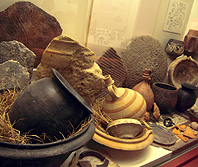 The
town of Verulamium was revealed in the 1930s by the excavations of
Sir Mortimer Wheeler. The artifacts he uncovered can
now be viewed at the Verulamium Museum, including
some of the
best examples of Roman mosaics to be found north of the Mediterranian,
along
with objects
of everyday
Roman life in recreated rooms, Roman coins,
pottery, and hands-on interactive displays. Lectures
are offered at the museum on weekends by St Albans guides. For walking
around the site, a multi-media tour, the "Veni
Vidi Verulamium" is
offered for free, either with a hand-held device available with
a deposit from the museum or downloadable to your own. The Verulamium
Museum is
open daily except Christmas and New Year. Admission for adults
is £3.50
and £2.00
for children. The Hypocaust, protected by a modern pavilion in
the park
is open for
free.
The
town of Verulamium was revealed in the 1930s by the excavations of
Sir Mortimer Wheeler. The artifacts he uncovered can
now be viewed at the Verulamium Museum, including
some of the
best examples of Roman mosaics to be found north of the Mediterranian,
along
with objects
of everyday
Roman life in recreated rooms, Roman coins,
pottery, and hands-on interactive displays. Lectures
are offered at the museum on weekends by St Albans guides. For walking
around the site, a multi-media tour, the "Veni
Vidi Verulamium" is
offered for free, either with a hand-held device available with
a deposit from the museum or downloadable to your own. The Verulamium
Museum is
open daily except Christmas and New Year. Admission for adults
is £3.50
and £2.00
for children. The Hypocaust, protected by a modern pavilion in
the park
is open for
free.
Roman Theater
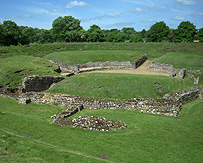 A
short walk from the Verulamium Roman Museum down St Michael’s
Street and across Hemel-Hempstead Road, is the excavated Roman Theater.
First unearthed in 1847, the foundations of the dressing rooms and circular
stage seating areas and stage are exposed in the
grassy fields. The theater was first built around 160 AD and later expanded
around 300 AD into a major entertainment complex which
could seat up to 2000 , until the Romans finally abandoned
the British Isle around 410 AD. Nearby are the foundations of a row of
shops built to satisfy the foot traffic
drawn
to the theater,
a villa and a secret temple. On privately owned land, viewing the Roman
Theater ruins requires a separate admission from the Verulamium Museum.
A
short walk from the Verulamium Roman Museum down St Michael’s
Street and across Hemel-Hempstead Road, is the excavated Roman Theater.
First unearthed in 1847, the foundations of the dressing rooms and circular
stage seating areas and stage are exposed in the
grassy fields. The theater was first built around 160 AD and later expanded
around 300 AD into a major entertainment complex which
could seat up to 2000 , until the Romans finally abandoned
the British Isle around 410 AD. Nearby are the foundations of a row of
shops built to satisfy the foot traffic
drawn
to the theater,
a villa and a secret temple. On privately owned land, viewing the Roman
Theater ruins requires a separate admission from the Verulamium Museum.
St Albans
is not only a roman site, but offers a variety of other history to
explore with its beautiful medieval Abbey and St Michael's Village. Guided
walks are offered through the tourist office. With the Elstree Film
studios nearby, St Albans
has
served
as the location of a number of movies and tv shows, doubling for many
other locations around England. St Albans is 20 miles north from the
center of London, accessible by rail from Kings Cross or Euston via
Watlford
Junction, by car, 10 minutes off the M1 or M25. © Bargain
Travel Europe
Find
best hotel and travel deals in London on
TripAdvisor
Web Info
St Albans Museums
These articles are copyrighted and the sole property of Bargain Travel Europe and WLPV, LLC. and may not be copied or reprinted without permission.
See Also:


